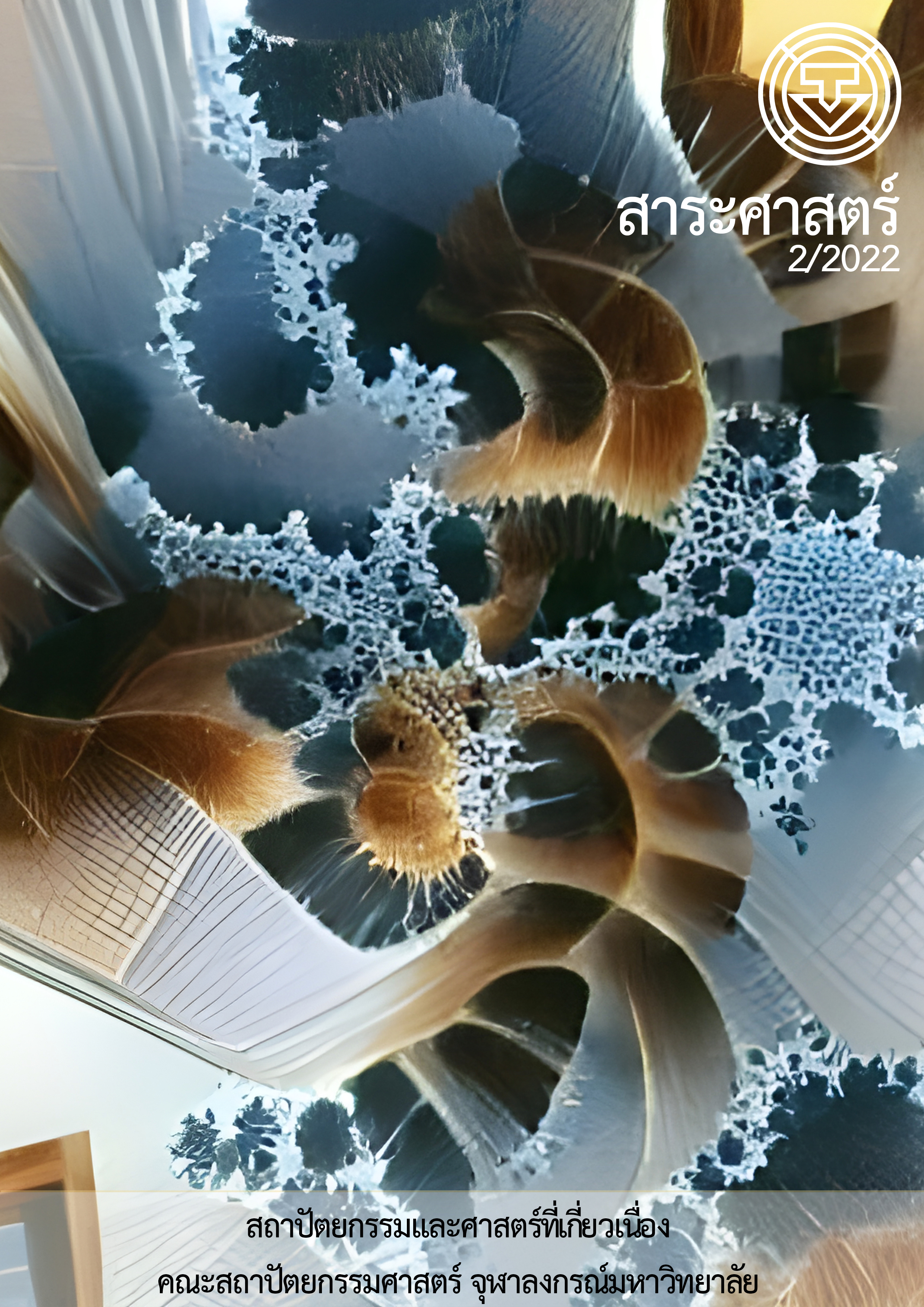Study of Physical Characteristics of Chinese Cemeteries in The Inner City of Bangkok
Main Article Content
Abstract
Chinese cemeteries in the inner city of Bangkok, defined as cultural landscape, have been being traced back for the evidence of Oversea Chinese settlements in the heart of Bangkok since the reign of King Rama V. However, as an urban development, cemeteries became less important, and many of them were neglected, resulting in an unappealing urban landscape. As a result, existing cemeteries are likely to be altered and relocated in the near future.
The objective of this paper is to examine and analyze the physical characteristics of seven remaining oversea Chinese public cemeteries in Bangkok's inner city, all of which are managed by five Chinese associations and one cemetery trust, by consideration of (1) setting and urban contexts (2) layout plan (3) building use and architectural styles (4) architectural styles of tombs and columbaria, and (5) landscape elements. The research method focuses sites inventory, involved person interviews, and paper sources.
The study reveals the physical characteristics of seven Chinese public cemeteries representing six Chinese dialect groups, all of which were traditionally established on the city's eastern and southern outskirts. The cemeteries provide the city's open space, with more hardscape than softscape, although the common zones comprise a high amount of canopy trees. The cemeteries have a one-way entry and are divided into three zones: service zone, funeral zone, and tombs and columbarium zone. There are two different types of tomb arrangements: (1) Irregular cemeteries plan includes a variety of tombs, including their grouping, orientation, size, and style of decorations. (2) A regular cemeteries plan, which considers the unity of cemeteries, covers their grouping and characteristics of tombs, as well as increasing the elements in common areas such buildings and landscapes.
Article Details
References
นนทพร อยู่มั่งมี. (2557). การจัดการพื้นที่เมืองในกรุงเทพมหานคร กรณีป่าช้าและพิธีศพสมัยรัชกาลที่ 5. วารสารวิชาการสงขลานครินทร์ ฉบับสังคมศาสตร์และมนุษยศาสตร์, 20(3), 59-88.
นวพร เรืองสกุล. (2551). สีลม ย่าหยา และ ตำราอาหาร. กรุงเทพฯ: Knowledge Plus.
นวรัตน์ เลขะกุล. (2522). ฮวงจุ้ย. วารสารเมืองโบราณ, 5(6), 84-93.
นิภาพร รัชตพัฒนากุล. (2562). นาสิกประสาตภัย : ประวัติศาสตร์ของกลิ่นเหม็นในเมืองกรุงเทพฯ. ศิลปวัฒนธรรม, 40(3), 118-29.
บัณฑิต จุลาสัย และ รัชดา โชติพานิช. (2562). เขตวัดยานนาวา. สืบค้นเมื่อ 6 มกราคม 2564, จาก https://www.matichon.co.th/columnists/news_1558369
ประพิณ มโนมัยวิบูลย์. (2556). ชุมชนจีนในประเทศ : หลากหลายสำเนียงจีน. วารสารราชบัณฑิตยสถาน, 76(4), 540-52.
ปรารถนา โกเมน. (2533). สมาคมชาวจีนในกรุงเทพฯ พ.ศ. 2440-2488. (วิทยานิพนธ์ปริญญามหาบัณฑิต, จุฬาลงกรณ์มหาวิทยาลัย).
เปรมา สัตยาวุฒิพงศ์. (2546). แรงงานรับจ้างชาวจีนในกรุงเทพฯ ตั้งแต่ พ.ศ. 2425-2492. (วิทยานิพนธ์ปริญญามหาบัณฑิต, จุฬาลงกรณ์มหาวิทยาลัย).
ไพรถ เลิศพิริยกมล. (2547). "ฮวงจุ้ย" ความเชื่อถือและปฏิบัติที่สืบต่ออย่างน่าพิศวง. สืบค้นเมื่อ 7 ธันวาคม 2564, จาก https://thaifolk.com/doc/literate/hungjui/hungjui1.htm
เมธินีย์ ชอุ่มผล. (2561). ล้างป่าช้าในบางกอก. สืบค้นจาก https://lek-prapai.org/home/view.php?id=5335
วทัญญู เทพหัตถี. (2563). ย้อนวันวานประวัติศาสตร์ถนนสีลมสู่ Park Silom สถาปัตยกรรมเชิง Mixed Use แลนด์มาร์คใหม่กลางเมือง. สืบค้นเมื่อ 5 มกราคม 2565, จาก https://techsauce.co/saucy-thoughts/relive-the-history-of-silom-road-to-park-silom
ศศิภา พูลบูลย์. (2556). ระบบวิเคราะห์แบบศพสถาปัตยกรรมภายในตามหลักฮวงจุ้ย. (วิทยานิพนธ์ปริญญามหาบัณฑิต, มหาวิทยาลัยศิลปากร).
สมาคมฮกเกี้ยนแห่งประเทศไทย. (2545). อนุสรณ์ครบรอบ 90 ปี สมาคมฮกเกี้ยนแห่งประเทศไทย. กรุงเทพฯ: สมาคมฮกเกี้ยนแห่งประเทศไทย.
สุดารา สุจฉายา. (2559). พระนครบันทึก : บ้านทวาย : สิ้นชื่อ สิ้นคน เหลือแต่ยำทวาย. สืบค้นเมื่อ 6 มกราคม 2565, จาก https://lek-prapai.org/home/view.php?id=752
แสงอรุณ กนกพงศ์ชัย. (2554). กตัญญูในกงเต๊กและกงเต๊กในกตัญญู : พิธีกงเต๊กในสังคมไทยและสังคมโลก. กรุงเทพมหานคร: สำนักพิมพ์แห่งจุฬาลงกรณ์มหาวิทยาลัย.
อนุสรณ์ มั่นสัณฐิติ. [ม.ป.ป.]. ๑๐๐ ปี เขตยานนาวา. กรุงเทพฯ: สำนักงานเขตยานนาวา.
อรวรรณ ศรีอุดม. (2535). วันวาน...กับวันนี้ของถนนสีลม. กรุงเทพมหานคร: ธนาคารไทยทนุ.
อู๋จี้เยียะ. (2553). 60 ปี โพ้นทะเล. แปลโดย ปนัดดา เลิศล้ำอำไพ. กรุงเทพฯ: โพสต์บุ๊ค.
กัณฐิกา ศรีอุดม. (2564, 23 พฤศจิกายน). สัมภาษณ์.
จิรยุทธ์ สินธุพันธุ์. (2564, 23 พฤศจิกายน). สัมภาษณ์.
ทวีชัย พรวัฒนวิชัย. (2565, 5 กุมภาพันธ์). สัมภาษณ์.
เรย์มอนด์, โจว. (2564, 14 ธันวาคม). สัมภาษณ์.
สมชาย สุขเจริญ. (2564, 8 มกราคม). สัมภาษณ์.
Dian, Zhang. (2004). Land for the dead: Locating urban cemeteries, case study Guilin. (Master’s thesis, ITC Enschede).
Fan, Pik, Voon Phin Keong, Siew Ong, & Hong Ching Goh. (2014, July). Chinese cemeteries and environmental ethics: Some insights from Malaysia. 41, 85-105.
Groot, Jan Jakob Maria. (1897). The religious system of China: Its ancient forms, evolution, history and present aspect, manners,customs and social institutions connected therewith; Vol. 3: Dutch colonial government. Retrieved from https://archive.org/details/religioussystemo03groo/page/n7/mode/2up
Han, Ke-Tsung. (2001, September). Traditional Chinese site selection-Feng Shui: An evolutionary/ecological perspective. Journal of Cultural Geography, 19, 75-96. Retrieved from https://doi.org/10.1080/08873630109478298
Lo, Joseph Yau Hing. (1997). A Chinese cemetery for the winnipeg community: A response to the Feng-Shui concept. (Master’s thesis, University of Manitoba).
Loo, Yat Ming. (2013). Architecture and urban form in Kuala Lumpur. Farnham: Ashgate.
Loo, Yat Ming. (2020). Multicultural burial spaces and cities: Constructing identity and memory with postcolonial Kuala Lumpur Chinese cemeteries. In Jessica L. Nitschke & Marta Lorenzon (Eds.), Postcolonialism, heritage, and the built environment: New approaches to architecture in archaeology (pp.109-127). Cham: Springer.


